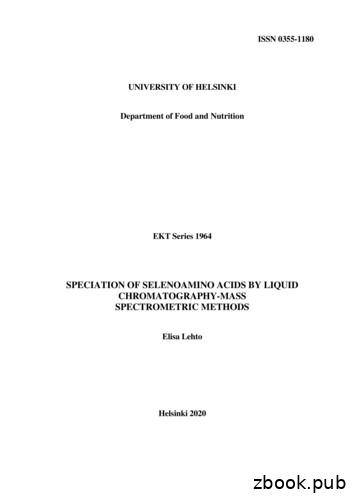Liquid Chromatography (HPLC) Chapter 28: High-Performance
Chapter 28: High-PerformanceLiquid Chromatography (HPLC) Scope Instrumentation – eluants, injectors, columns Modes of HPLC– Partition chromatography– Adsorption chromatography– Ion chromatography– Size exclusion chromatography
HPLC Most widely used separation technique Broad applicability – organic & inorganic Can be very sensitive, accurate & precise Suitable for separation of nonvolatilespecies Has found numerous uses in industry,clinical settings, environmental areas,pharmaceuticals, etc.
Solvents (mobile phase) – are storedin special reservoirs connected to thepumping system – must be free ofparticles that can clog components & free ofbubble forming gases that get trapped incolumn or detectorThree basic ways to degas solvents1) vacuum or suction filter (0.4 or 0.2 µm)2) ultrasonicate (with vacuum)3) He purge (sparge units often built in)Can purchase HPLC solvents & water - still
HPLC pumping systems typicallyemploy two reciprocating orpiston pumpsCheck valves& pump sealsneed to bereplacedPulse-freeflow is neverreallyachieved
In GC the analyte affinity for thecolumn is influenced by tempIn HPLC the solvent strengthaffects an analytes retention on columnTherefore, analogous to temp programmingin GC, do solvent programming in HPLCThis is also referred to as gradient elution
Gradient elutiondramaticallyimproves theefficiency ofseparation
HPLC sample injectors areexclusively 6 port valves thatare overfilled by syringe givingextreme accuracy & precision – typicalvolumes are 10 to 50 µL but can be larger
Rotary Injection ValveCommon for HPLC, rare in GC
Injector for HPLC6 port rotary valve
Columns- usually stainless steel- can be PEEK (poly ether ether ketone)- may cost 200- 1000 packed- Length 10-30 cm, ID 4-10 mm- Packings are 3, 5, or 10 µm particle size- Most common 25 cm, 5 µ, 4.6 mm ID- N 40,000 to 60,000- Normally packed under 6000 psi pressureat factory as a slurry
Guard columns are normally usedbefore the analytical column toprotect & increase lifetime ofcolumn – operator usually slurry or drypacks short guard column regularly withsame or similar packing used in analyticalcolumn (old column material) – canpurchase guard systems, cartridges, etc.
Detectors for HPLC- Ideal characteristics same as GC- Exception is temp range- Low dead volume 1 to 10 µLMost common detector is UV-visabsorbance detectorThree types1) Filter instrument – optical filters, Hg lamp2) Variable wavelength – monochromator3) Diode array detector- provide spectra
Many HPLC detectors availableFor universal & selective detection
1) Filter based UV-vis detector –Typically set at 254 nm usingthe most prominent band inHg spectrum – can also use 313,365, 334 nm and other lines as well2) Variable wavelength detectors – usecontinuum source like (D2 or H2) & amonochromator, select any λ, lesssensitive3) PDA - D2 or H2 source, disperse & focuson diode array, get complete spectrumevery 1 sec, powerful, expensive, lesssensitive, lots of data generated
Cell forUV-visdetectorfor HPLC- Low vol
Diode Array Detector
Fluorescence detector – normallyfixed wavelength filter fluorometerexcitation filter & emission filtercan be changed for particular λ of interestgives selectivity based on:- ability to exhibit fluorescence- excitation wavelength- emission wavelengthVariable λ monochromator basedfluorescence detectors also availableFilter based detectors usually more sensitive
Refractive index detector (RI) responds to nearly all solutesbut has poor sensitivity – detectschanges in refractive index as samplepasses through as long as solute hasdifferent RI than solvent – analogous toTCD in GC
Electrochemical Detection Amperometric – fix potential &measure current (i) Conductometric – measure conductivity Coulometric – fix potential & integrate i Voltammetric – vary potential & measure i Potentiometric – measure potentialCan use 2 or 3 electrode design with Pt orcarbon electrodes (glassy C or C paste)Electrochem. detector nearly universal
Other HPLC detectors LC-MS using thermospray – newpopularity (pharmaceuticals) Evaporative light scattering - polymers LC-FTIR LC-plasma emission or ICP-MS
Instrumentation – eluants, injectors, columns Modes of HPLC – Partition chromatography – Adsorption chromatography – Ion chromatography . 6 port rotary valve. Columns - usually stainless steel - can be PE
Jun 01, 2016 · THIAMINE HYDROCHLORIDE HPLC H ilic HPLC HPLC to Hilic HPLC Add HPLC ID test Remove pH test THIAMINE MONONITRATE HPLC Hilic HPLC HPLC to Hilic HPLC Add HPLC ID test Remove pH test NIACINAMIDE n/a n/a Remove Melting Range ADENINE HPLC to UPLC HPLC to UPLC n/a CALCIFEDIOL n/a add HPL
2.3.1 Liquid chromatography (LC) 20 Size-exclusion chromatography (SEC) 20 Ion-exchange chromatography (IEC) 22 Reversed-phase chromatography (RP) 23 Reversed-phase ion pairing chromatography (RPIP) 24 2.3.2 Gas chromatography (GC) 25 2.3.3 Electrophoretic techniques 25 2.3.4 Isotope dilution analysis (IDA) 26 3 EXPERIMENTAL RESEARCH 27 Aims 27
Gradient elution in liquid chromatography is analogous to temperature programming in gas chromatography. Increased eluent strength is required to elute more strongly retained solutes. RP-HPLC (increase organic, make more non-polar). NP-HPLC (increase solvent to make more polar)
1. Theory of liquid chromatography. High performance liquid chromatography (HPLC) is a technique for separating analytes dissolved in a liquid, mobile phase by using their specific interaction with a stationary phase (chromatography column). Depending on the type of interaction of the sample molecules with both mobile and stationary phases,
Lecture Overview Rate theory of HPLC van Deemter equation Principle of LC analysis - HPLC subclasses - Stationary phases in HPLC . Separation process in reversed-phase liquid chromatography . analyser Electrospray ionisation (ESI) source Two concentric steel tubes carry the liquid and nebulising gas. After nebulisation, additional gas
Chromatography 481 27.4.2 Partition (Liquid–Liquid) Chromatography 482 27.4.2.1 Introduction 482 27.4.2.2 Coated Supports 483 27.4.2.3 Bonded Supports 483 27.4.3 Ion-Exchange Chromatography 483 27.4.4 Size-Exclusion Chromatography 485 27.4.5 Affinity Chromatography 488 27.5 Analys
HPLC: historical overview The discovery of chromatography dates back to 1903, when Mikhail Tswett's research in the . immiscible liquid (chloroform) through a packed tube and hence developed liquid-liquid partition chromatography [4]. In a later experiment, the liquid mobile phase was replaced by a gas vapor, which
The grid, one of the oldest architectural design tools, is a useful device for controlling the position of building elements. Grids have been and continue to be used in all manner of layout tasks from urban design to building construction (see figure 1) . A grid can help a designer control the positions of built and space elements, making the layout task more systematic. By determining .























